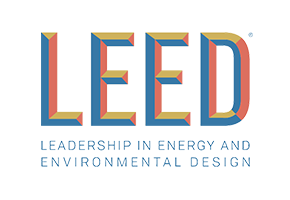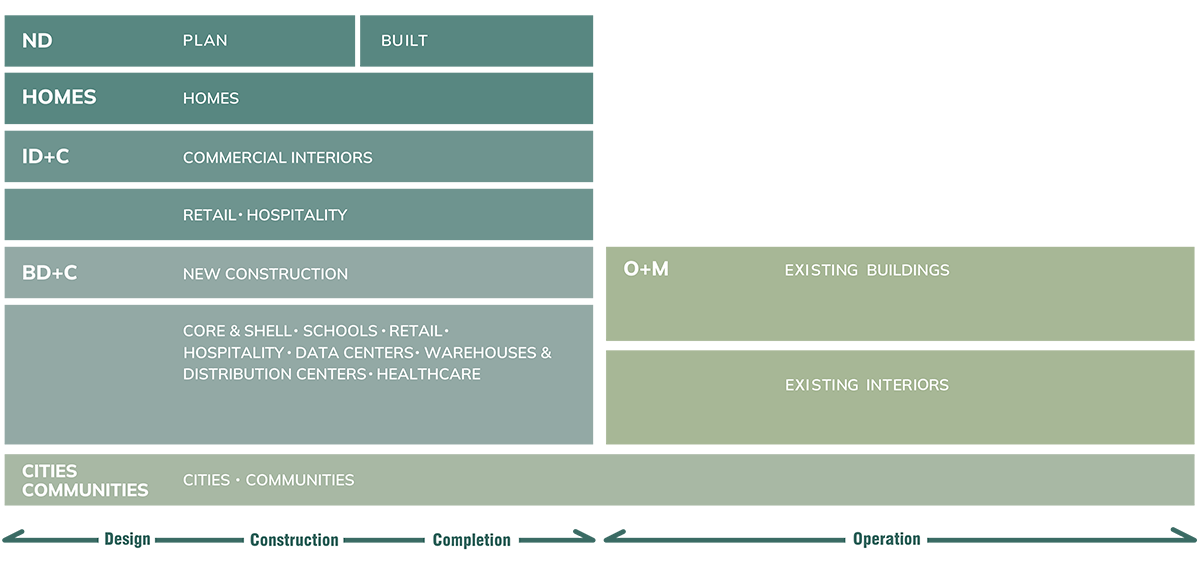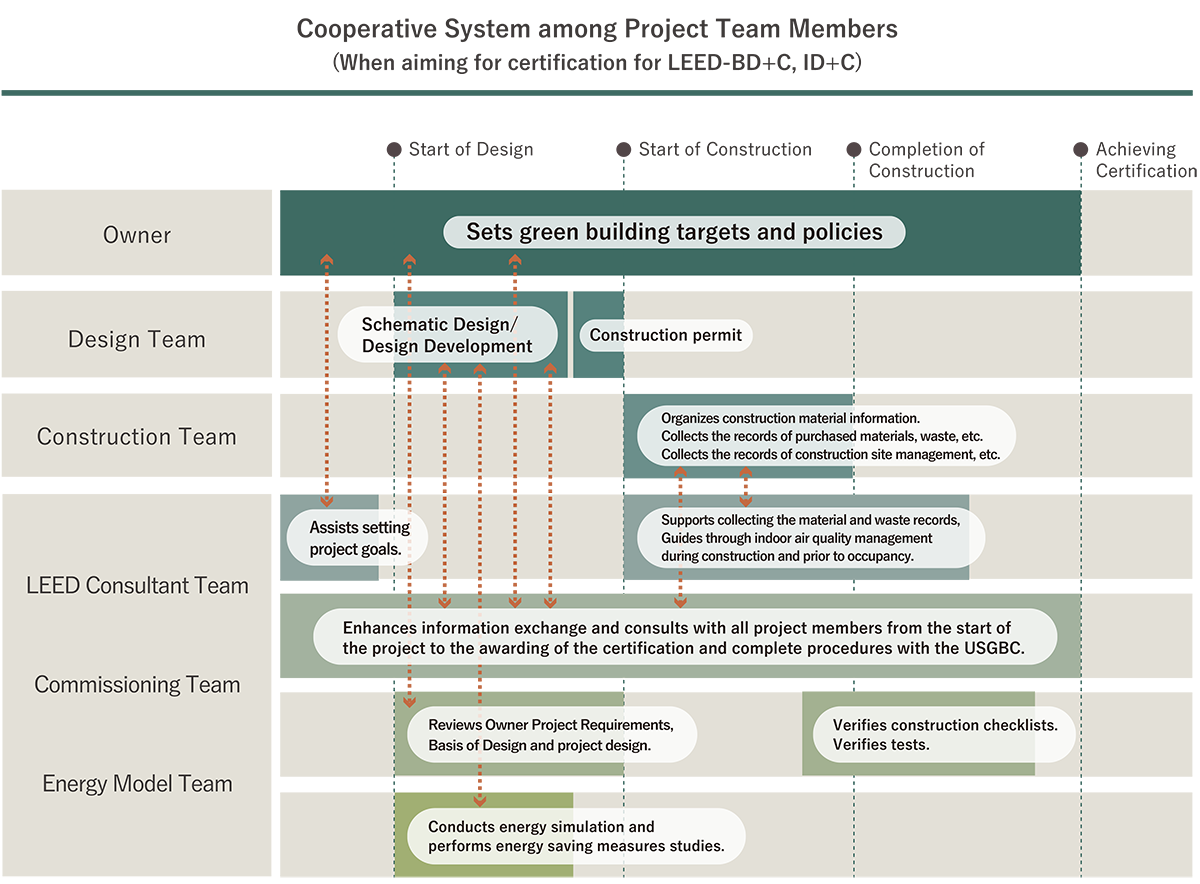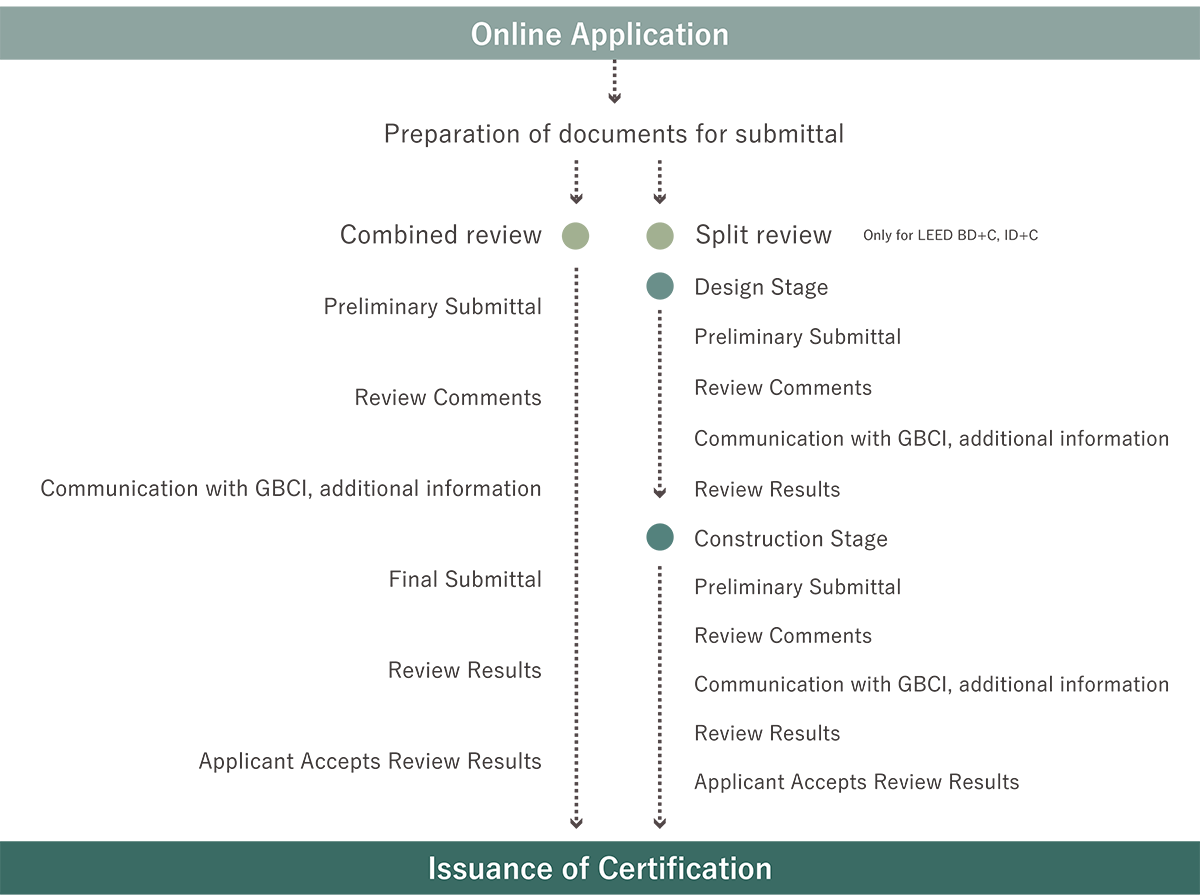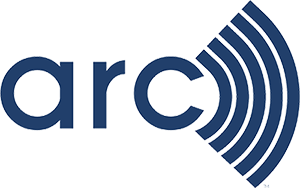1. What is LEED®
LEED® is a rating and certification system for evaluating built environments developed and operated by the U.S. Green Building Council® (USGBC®). It is named Leadership in Energy and Environmental Design because it is a system that leads the way in energy conservation and environmentally conscious building and site use. The acronym LEED® stands for Leadership in Energy and Environmental Design. The U.S. Green Business Certification Inc.™ conducts the review. (GBCI®).
According to the USGBC®, LEED® “provides a framework for healthy, high efficient, and cost-saving green buildings, which offer environmental, social, and governance benefits.” LEED can also help address climate change by reducing carbon emissions. LEED encompasses resilience and equitability, therefore, is a tool to measure and achieve ESG goals., improve resilience, and strengthen equitable communities.
LEED® is a comprehensive system that looks at the whole building picture, incorporating all the elements important to creating the best buildings rather than just focusing on one element of a building, such as energy, water, or health.
LEED® aims to achieve building excellence in the following areas:
- ・Climate change mitigation
- ・Improving health
- ・Protect and restore water resources
- ・Protect biodiversity and enhance ecosystems
- ・Promote sustainable and renewable building material cycles
- ・Improve quality of life (QOL) in communities
LEED® was launched in the United States in 1998, and according to data released by the USGBC® in March 2023, it has spread worldwide with project registrations in over 185 countries. Click here for up-to-date information on the status of LEED® adoption worldwide and the number of LEED® professionals. Select a country to view a country-by-country summary.
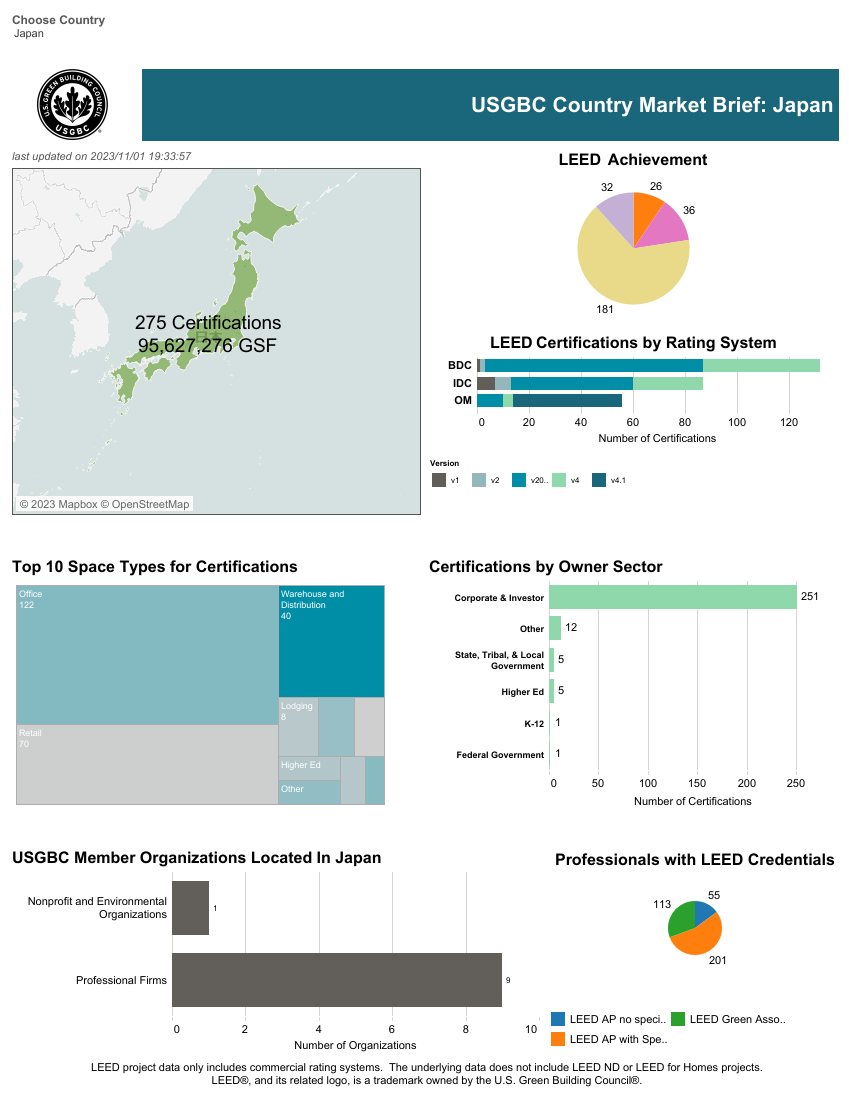
In recent years, LEED® has been rapidly gaining traction in the U.S. and other parts of the globe, including Japan. To promote LEED® outside of the U.S., organizations have been formed in various countries, and cooperative actions have been taken with the USGBC®, such as making national standards available for LEED®. In Japan, Green Building Japan (GBJ) was established in 2013.
2. Rating Systems
With LEED®, the most appropriate system for the project must be selected, depending on the building or space type and usage, and documents are submitted for certification. The characteristics of each LEED® certification system and the eligible project types are as follows.
■ LEED® for Building Design and Construction
LEED® Building Design and Construction (BD+C) evaluates an entire building’s new construction or major renovation. Within BD+C, the most appropriate system based on the use and characteristics of the building is selected.
- ・New Construction and Major Renovation
- ・Core and Shell Development
- ・Data Centers
- ・Healthcare
- ・Hospitality
- ・Retail
- ・Schools
- ・Warehouses and Distribution Centers
■ LEED® for Interior Design and Construction
LEED® Interior Design and Construction (ID+C) evaluates building interior design and construction processes. This is the rating system of choice for tenants seeking LEED® certification for their tenant space.
- ・Commercial Interiors
- ・Retail
- ・Hospitality
■ LEED® for Building Operation and Maintenance
Building Operation and Maintenance (O+M) evaluates management, operational improvements, and minor renovations to existing buildings. Unlike BD+C (new construction), Arc can be used for certification.
What is Arc
- ・Existing Buildings
- ・Existing Interiors
■ LEED® for Residential Design and Construction (Homes)
LEED® for Residential Design and Construction (Homes) evaluates the design and construction of single-family homes and multi-family residential buildings of three stories or less.
■ LEED® for Neighborhood Development
LEED® Neighborhood Development (ND) evaluates mixed-use area developments from the planning stages through design and construction. The most appropriate system is selected based on the progress of the mixed-use area development construction.
- ・Plan
- ・Built project
■ LEED® for Cities and Communities
A certification system designed to improve the sustainability and quality of life (QOL) of cities and communities. It comprehensively evaluates key aspects of natural ecosystems, energy, water, waste, transportation, and quality of life. LEED® for Cities and LEED® for Communities, which can include private companies, area management organizations, and educational institutions, have two versions: the Plan and Design version, which evaluates cities and communities in the planning stages, and the Existing version, which evaluates existing cities and communities.
LEED® for Cities
LEED®for Cities is a certification program undertaken at the administrative level (mainly at the municipal level in Japan).
LEED® for Communities
LEED® for Communities is a certification program that works on a smaller scale than administrative units, such as districts, regions, and multiple city blocks.
LEED® BD+C and other "design" systems are evaluated only once for new construction, while LEED® O+M, which evaluates "operations," recommends that certification be renewed at least every three years after certification. The LEED® certification system is also updated every few years.
3. Categories
LEED® has established several evaluation categories to assess the environmental performance of buildings and site use from various perspectives. Each item consists of mandatory and optional (point-earning) items that evaluate environmental performance in that area.
To achieve LEED® certification, the requirements of all mandatory items must be met. On top of that, by meeting the requirements of the optional (point-earning) items, the applicant can earn the points allocated to those items. The total score for all items is 110 points.
Each LEED® rating system consists of the following categories. The categories and requirements vary depending on the certification system selected.
■ LEED® BD+C/ID+C/O+M/Homes
Evaluation items, details of requirements, and the weight of each requirement differ depending on the authentication system (BD+C/ID+C/O+M) selected.
Category
Explanation

Integrative Process
(*Not included in O+M)
Through early analysis of synergies between systems, we encourage and target the involvement of project members in each area early in the planning process with the goal of obtaining high-performance, cost-effective results.

Location and Transportation
We evaluate the location and transportation conditions of the project site from a sustainability perspective.

Sustainable Sites
(*Not included in ID+C)
With the goal of minimizing impacts on ecosystems and water resources as much as possible, we evaluate biodiversity conservation, stormwater runoff control, heat island protection, and light pollution reduction. For O+M, points are given to LEED NC projects and for the creation of a site management policy.

Water Efficiency
We evaluate the reduction of potable water used inside and outside of buildings through efficient irrigation methods, water-saving fixtures, and the effective use of rainwater and gray water.

Energy and Atmosphere
We evaluate the energy efficiency of the equipment and envelope, the purchase of green electricity, and the absence of chlorofluorocarbon (CFC) refrigerants. Commissioning of equipment by a third party independent of the designer/builder and, in O+M, building energy audits are also included.

Materials and Resources
To encourage sustainable building materials and waste reduction, we will evaluate the separation and recycling of construction waste and building waste and the use of reused building materials, building materials containing recycled materials, and locally produced materials. O+M will evaluate the implementation of regular waste audits and the creation of purchasing and recycling policies.

Indoor Environmental Quality
We evaluate the amount of ventilation, tobacco smoke control, thermal and light environment, natural light intake, and views from windows to ensure a comfortable indoor environment. O+M will also evaluate the development and implementation of a green cleaning policy that considers the environment and the health of building users.

Innovation
This category recognizes projects that have achieved design excellence (performance) through innovative ideas or performance that exceeds the LEED® requirements. Points are also awarded for having a LEED® Certified Professional on the project team.

Regional Priority
Incentives are provided to achieve credits that address geographically unique environments, social justice, and public health priorities.
■ LEED® ND

Smart Location and Linkage
The selection of development areas and site use will be evaluated in terms of the preservation of natural resources, avoidance of uncontrolled sprawl, and availability of public transportation. Specifically, the area must have water, sewer, and transportation infrastructure; preserve biological habitats, wetlands, water bodies, green spaces, and agricultural lands within the development area; and avoid flood risks.

Neighborhood Pattern and Design
The walkability of the development area, connectivity to the surrounding area, and the availability of convenient living facilities within walking distance will be evaluated. In addition, initiatives such as compact development, affordable housing provision, public space enhancement, and shaded green streets are important aspects of this category.
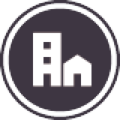
Green Infrastructure and Buildings
We evaluate the environmental performance of infrastructure and buildings in the development area. Energy and resource conservation, water conservation, waste management, use of renewable energy, district heating and cooling, heat island control, torrential urban rainfall, flood control, and preservation of historic buildings and landscapes are all required. At least one LEED®-certified (or to be LEED®-certified) building in the development area is also one of the mandatory requirements.

Innovation
This category recognizes projects that have achieved design excellence (performance) through innovative ideas or performance that exceeds the LEED® requirements. Points are also awarded for having a LEED® Certified Professional on the project team.

Regional Priority
Incentives are provided to achieve credits that address geographically unique environments, social justice, and public health priorities.
■ LEED® for Cities and Communities

Integrative Process
The practice of an integrated planning process, in which a team of diverse experts and stakeholders from across disciplines is involved in the review process, is required. In addition, the availability and content of policies, incentives, and programs that encourage green building will also be evaluated.

Natural Systems and Ecology
This item calls for the preservation of local ecosystems, prevention of pollution from construction activities, creation and preservation of green spaces necessary for the health and well-being of the community, and improvement of environmental quality. Light pollution reduction and resilience planning also fall under this item.

Transportation and Land Use
It evaluates compact development and access to a variety of uses to reduce urban sprawl and improve public health. Walkability and Bikeability are the central concepts of this category, which requires a shift away from car dependence. The promotion of alternative fuel vehicles and smart mobility will also be evaluated.

Water Efficiency
This category addresses water from various perspectives, including meeting growing urban demand for water, maintaining water quality, preventing leakage, using rainwater, and managing urban flooding. The use of green infrastructure is also evaluated.

Energy and Greenhouse Gas Emissions
This category encourages cities to provide easy access to stable electricity and reduce energy use's negative environmental impacts. Reducing greenhouse gas (GHG) emissions, promoting renewable energy, and decarbonization are central challenges in this item.

Materials and Resources
This item promotes the transition from a linear economy (linear mass production, consumption, and disposal economy) to a circular economy in cities with large concentrations of materials. The program evaluates recycling, reuse, and reduction initiatives, infrastructure development to support these initiatives, and responsible procurement.

Quality of Life
This category involves designing and planning to promote prosperity, health, and safety. It seeks to assess the demographics and attributes of a city or community, provide appropriate social infrastructure, and prepare a pathway for economic growth. Opportunities for resident participation, social equity, human rights, environmental justice, and affordable housing and transportation are also included in the evaluation.

Innovation
This category recognizes projects that have achieved design excellence (performance) through innovative ideas or performance that exceeds the LEED® requirements. Points are also awarded for having a LEED® Certified Professional on the project team.

Regional Priority
Incentives are provided to achieve credits that address geographically unique environments, social justice, and public health priorities.
※Icon images reprinted from the USGBC® LEED® official website
4. LEED® Accredited Professionals
LEED® Accredited Professionals are technicians recognized by the USGBC® for their expertise in LEED®. Certifications are available in the BD+C, ID+C, O+M, ND, and Homes specialties, and successful completion of the certification exam qualifies a person to become a LEED® Accredited Professional. LEED® Accredited Professionals provide advice and assistance to buildings and site users seeking certification to meet the requirements of the LEED® rating system. Woonerf has several LEED® Certified Professionals in all areas of expertise.

5. Process
A project team seeking LEED® certification requires the participation of multidisciplinary experts, including building owners, designers, managers, constructors, LEED® consultants, commissioning engineers, and energy modeling engineers.
All communication related to the application process and submission of application documents for certification is done online.
<Application Procedure>
1. Registration with LEED® Online
Once a project has been registered with LEED® Online by entering basic project information (project name, location, expected start date, expected completion date, building owner name, etc.), LEED® Online will be available.
2. Preparation of application documents
Gather the necessary information and prepare the LEED submittal document for the credits to be attempted.
3. Selecting the review method
Applications for LEED®, BD+C, and ID+C certification can be submitted through either a combined review or a split review (design phase review + construction phase review). The applicant can decide which one to choose.
4. Reviews
If the applicant chooses the combined review, the initial review application for both design-related and construction-related items will be submitted at the same time when the application documents have been prepared. After the initial review, the USGBC® review team will return the results with questions. The applicant is required to prepare and submit a final review document with additional materials and reinforcements based on the questioned items. LEED® certification will be issued based on the scores determined at the final review. If the applicant chooses to undergo a split review, the design-related items and construction-related items are submitted separately. In both cases, certification will be issued after the initial review, return of review results and questions, additional materials and reinforcement explanation, and final review, as in the application procedure for the combined review described above.
6. Certification levels
LEED® is rated on a 4-level scale (Certified, Silver, Gold, and Platinum) based on the score in the scoring section after all required items have been met. Scores of 40, 50, 60, and 80 points or higher are required, respectively.

7. Fees
LEED® certification requires a project registration fee, a review fee, and a consulting fee. Project fees vary depending on the project floor area and whether the project uses a combined or split review. For more information on fees, please refer to the link below.
Note: USGBC® and GBCI® do not endorse this LEED® summary which is the sole creation of Woonerf. For more information about the LEED® Standard, please visitusgbc.org/LEED
What is Arc
Arc compares five key performance indicators (KPIs) - energy, water, waste, transportation, and comfort - for buildings and cities with other green building databases and other data collected worldwide to produce a 90-point scale called a performance score. The score is then entered into a data entry system. The score is updated each time the data is entered, allowing the user to check the performance score based on current operations in real-time.
Using "current performance" as a starting point, the system is designed to visualize progress toward newly set goals and to share with all parties involved which items are highly accomplished and which need improvement.
Arc makes it possible to remove the complexity and hurdles in the decision-making process that often arise between multiple stakeholders and to push things forward simply.
Arc is a global platform that provides a dynamic scoring model for real estate ESG performance, developed by Arc Skoru, a wholly owned subsidiary of Green Business Certification Inc.™, which is responsible for reviewing LEED® and WELL, international certifications that evaluate the environmental and health performance of buildings and cities. In Japan, Arc Japan Inc. is promoting the platform.
USGBC® and GBCI® have been collecting operational data on green buildings for the past 25 years, and the system is available to all projects, regardless of LEED® registration, that seeks to improve performance related to sustainability and human health. All projects include a wide variety of buildings worldwide, including offices, retail stores, shopping malls, public facilities, hotels, schools, logistics facilities, sports facilities, housing complexes, hospitals, senior care facilities, and factories, as well as multi-building neighborhoods, communities, and cities (municipalities).
In terms of continuity of evaluation from "new buildings" to "existing buildings," LEED® BD+C (LEED® for new buildings) can be applied to LEED® O+M (LEED® for existing buildings) after the building becomes operational. The subsequent transition to Re-Certification can be completed in a very simple procedure using the performance score described above. Similarly, for "New Surface Development" and "Existing Towns and Municipalities,” the performance scores described above can be used to transition from LEED® ND (Town Development version of LEED®) to LEED® Community and LEED® Community <(existing> and LEED® City Certification Performance scores can also be used for new "Existing Towns and Municipalities" to newly achieve certification.
In addition to the certification systems mentioned above, Arc also provides a centralized platform for understanding a project's current performance on a variety of indicators, including assessing climate change risk, calculating percentile values when comparing performance to similar projects, comparing performance to the GRESB energy average, and identifying stranded points in the CRREM pathway. We will continue to implement new features as a tool to support sustainability efforts at the asset level.
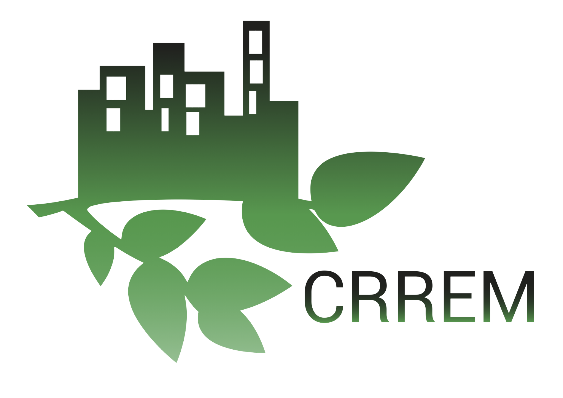
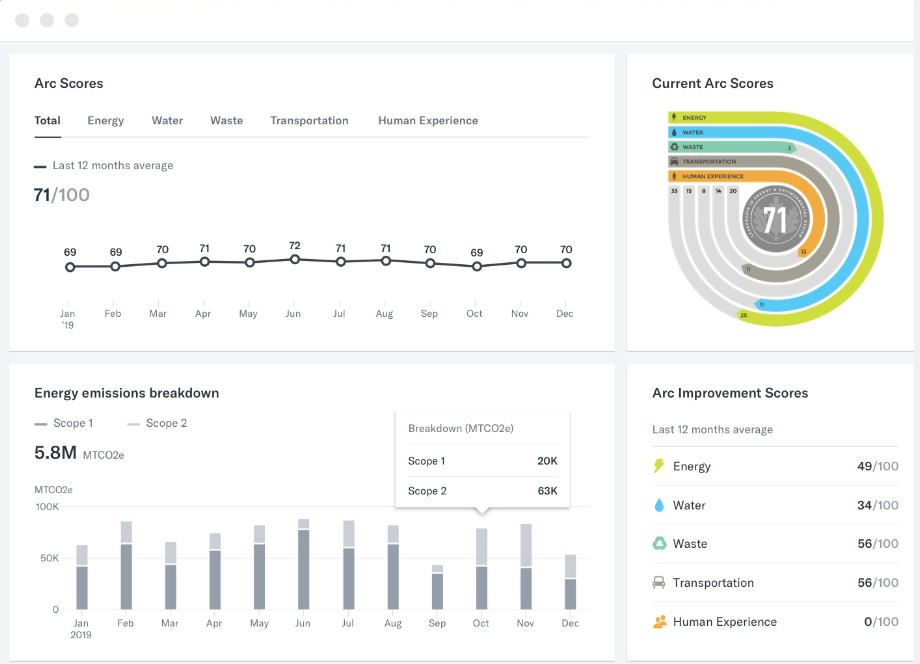

 Page Top
Page Top